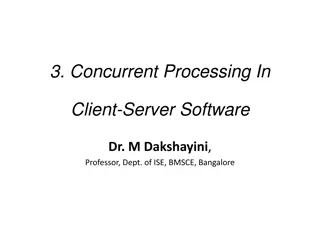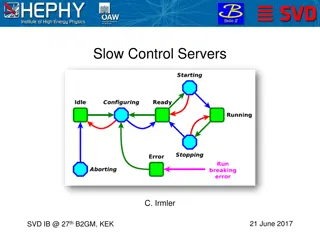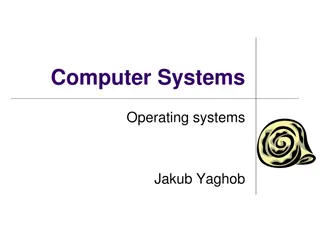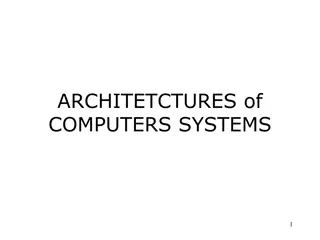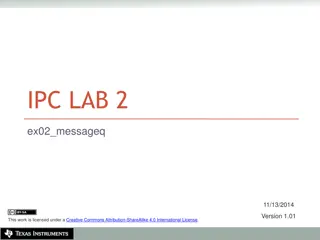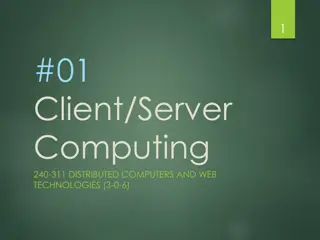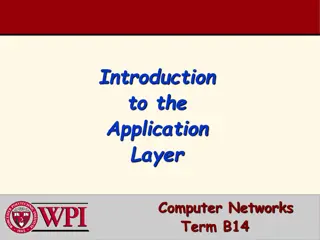System Architectures and Client/Server Models
System architectures serve as models that define relationships between entities and communication methods within a system. Various architectural styles such as client/server, peer-to-peer, and event-driven have their own advantages and drawbacks, influencing system performance. Client/server architectures entail multiple clients connecting to a single server, utilizing protocols for service requests and response understanding. Advantages like simple updates and identified disadvantages like single points of failure are discussed, along with the similarities and distinctions between client/server and peer-to-peer architectures.
Uploaded on Mar 16, 2025 | 2 Views
Download Presentation

Please find below an Image/Link to download the presentation.
The content on the website is provided AS IS for your information and personal use only. It may not be sold, licensed, or shared on other websites without obtaining consent from the author.If you encounter any issues during the download, it is possible that the publisher has removed the file from their server.
You are allowed to download the files provided on this website for personal or commercial use, subject to the condition that they are used lawfully. All files are the property of their respective owners.
The content on the website is provided AS IS for your information and personal use only. It may not be sold, licensed, or shared on other websites without obtaining consent from the author.
E N D
Presentation Transcript
What did we talk about last time? Fixed width types Systems Course themes System architectures
System architectures are models of systems that describe: Relationships between entities in the system Ways the entities communicate Different architectural styles have pros and cons Using a certain style can have big impacts on system performance Common styles: Client/server Peer-to-peer (P2P) Layered Pipe-and-filter Event-driven Hybrid
This book considers client/server architectures from the perspective of a many clients connecting to a single server If you recall, the Software Engineering book describes client/server as a system with many servers, each of which offer a single service How does a client know how to reach the server? Uniform resource identifier (URI) is a common way: www.goats.net/image.jpg Client/server architectures depend on protocols to define how clients can request services and understand the response Client 1 Client 5 Client 2 Server Client 4 Client 3
ADVANTAGES DISADVANTAGES Updates are simple, because only the server needs to be updated Only the server needs to be checked for security problems or data corruption Single point of failure To reduce the single point of failure problem, it's common to have multiple servers that offer the same services or files To work, these servers must coordinate with each other when one is updated
If more and more servers are used, the architecture begins to look like a P2P architecture BitTorrent DNS In P2P, there is usually no distinction between clients and servers, since most entities act as both Advantages: Service scales, staying the same or improving as the number of users goes up Disadvantages: Security: A corrupted node can be hard to detect Administration: Propagating changes can be difficult Node 1 Node 5 Node 2 Node 4 Node 3
Layered architectures divide systems into a strict hierarchy of components Each layer can only communicate with the layer above and below it Advantages: As long as a new layer knows how to talk to the layer above and below, it can be swapped out with an old layer New layers can be added on top Disadvantages: It's hard to divide systems into hierarchical layers It can be inefficient to prevent one layer from talking directly to one much lower or higher Some services at each layer are redundant Presentation Layer Business Layer Services Layer Persistence Layer
Pipe-and-filter architectures send data in one direction through a series of components The output of one stage is the input of the next Each stage transforms the data in some way Examples: Linux command-line piping sort foo.txt | grep -i error | head -n 10 > out.txt Java stream filtering Stages of a compiler Advantages: Good for serial data processing Modular components that have the same input and output can be reused in different sequences Disadvantage: No error recovery if something breaks in the middle
Event-driven architectures react to events, changes in the state of the system GUIs are a common example of event-driven architectures Event generator create events Event channels send the event to the appropriate event handlers Event Handler 1 Event Generator Event Channel Event Processing Event Handler 2 Advantages: Adding new event generators and handlers allows for an extensible system Good for reactive systems Disadvantage: Timing can be complicated, especially for shared resources Event Handler 3
We talk about the previous architectures because they're models that have been successful in the past Most real systems are a mix of different architectures The whole system could be one architecture, but its components have their own A system could be mostly one architecture but break a couple of rules There can be different ways of looking at the same system Example: OS kernel Event-driven because it has interrupt handlers to respond to signals from the hardware Client/server because applications that make system calls are making requests Layered because file systems and networking operate with layers from the generic operation down to the requirements of particular hardware
States are different, meaningful configurations that a system can be in They show up all over computer science Deterministic finite automata (DFA) are a simple model of computation equivalent to regular expressions State machines are useful for parsing State machines can express different states that a system (like a microwave or a enemy in a video game) can be in Transitions are changes from one state to another Events trigger transitions which then have effects, visible behavior
As discussed in COMP 3100, UML standardizes state models as a way to visualize states and transitions States are shown as rounded rectangles A solid circle shows the initial state A solid circle in a circle shows the final state Transitions are shown as labeled arrows Effects (if any) are written after a slash after the transition label
When constructing state machines from some other representation, it's possible to generate a large number of states For example, a different state for every configuration of bits in a 32-bit integer would mean 232 4 billion different states To be useful as models, there needs to be a reasonable number of states Different states can be grouped together based on what's meaningful for a given problem
State machines are often used to recognize strings as being legal or illegal Consider a state machine from Project 1 designed to recognize integer values (formatted in either decimal or octal) In addition to recognizing integers as legal or illegal, the machine builds the integer based on the effects
As COMP 3200 covers, regular expressions and finite state machines are equivalent For every regular expression, there's an equivalent FSM For every FSM, there's an equivalent regular expression Example: Regular expression: 1 0 1* FSM:
There are algorithms to convert between regular expressions and state machines Most regular expression libraries build a state machine as a way to see if strings match the regular expression One way to implement state machines is with a 2D array One row for every state One column for every event, saying which state a given state will transition to If there are effects, a second 2D array can show which effects happen on those transitions If an action happens whenever a state is entered, a 1D array can hold that information
The state model on the left has a transition table on the right Events States Connect Suspend Ready Finish Cancel Connecting Buffering Buffering Playing Closing Playing Buffering Closing Closing
Two enums are used to list the states and the events A 2D array stores the transitions typedef enum { CONN, BUFF, PLAY, CLOS, NST } ms_t; typedef enum { Connect, Suspend, Ready, Finish, Cancel } event_t; #define NUM_STATES (NST+1) #define NUM_EVENTS (Cancel+1) static ms_t const _transition[NUM_STATES][NUM_EVENTS] = { // Connect Suspend Ready Finish Cancel { BUFF, NST, NST, NST, NST }, // Connecting { NST, NST, PLAY, NST, CLOS }, // Buffering { NST, BUFF, NST, CLOS, NST }, // Playing { NST, NST, NST, NST, NST } // Closing };
A table filled with function pointers can be used for effects static action_t const _effect[NUM_STATES][NUM_EVENTS] = { // Connect Suspend Ready Finish Cancel { start_load, NULL, NULL, NULL, NULL }, // Connecting { NULL, NULL, resume, NULL, NULL }, // Buffering { NULL, pause_play, NULL, NULL, NULL }, // Playing { NULL, NULL, NULL, NULL, NULL } // Closing };
State models don't have any timing or sequence information Sequence models show the order in which messages are sent from one entity to another Solid arrows show synchronous messages Open arrows show asynchronous messages Dotted lines show responses Messages that end in circles are lost The order of messages in sequence models is logical, not scaled by time
Processes Multiprogramming Kernel
No class on Monday Work on Assignment 1 Due next Friday by midnight! Look over Project 1 Read sections 2.1, 2.2, and 2.3





